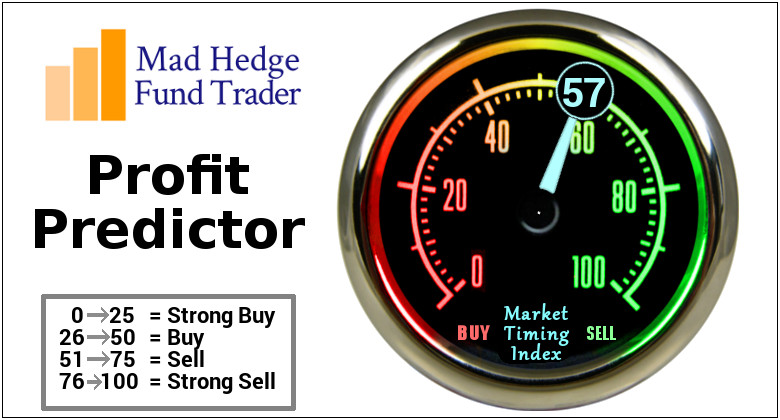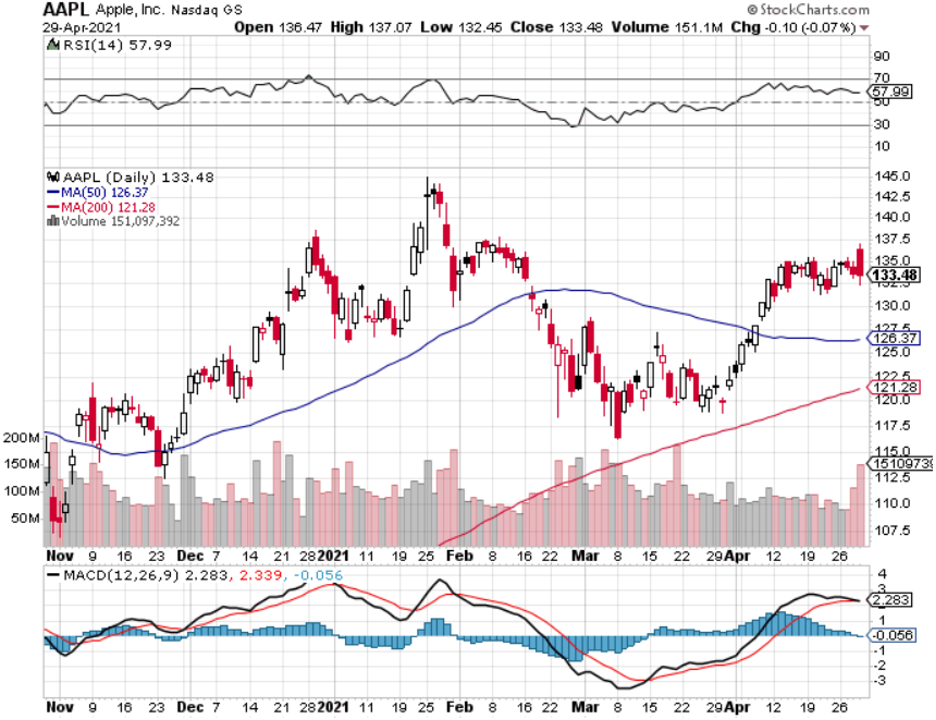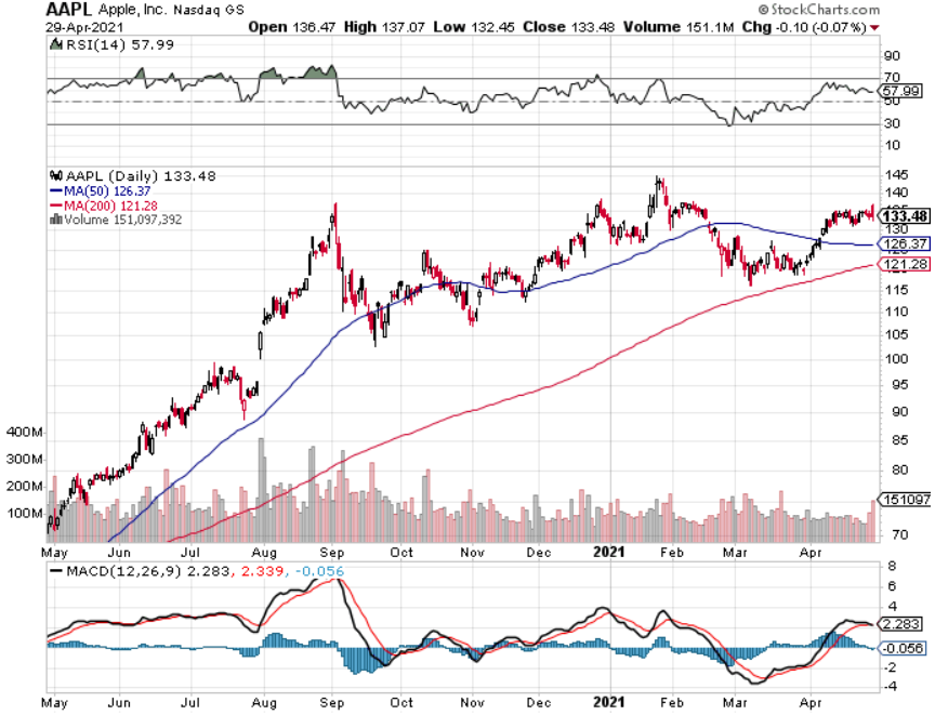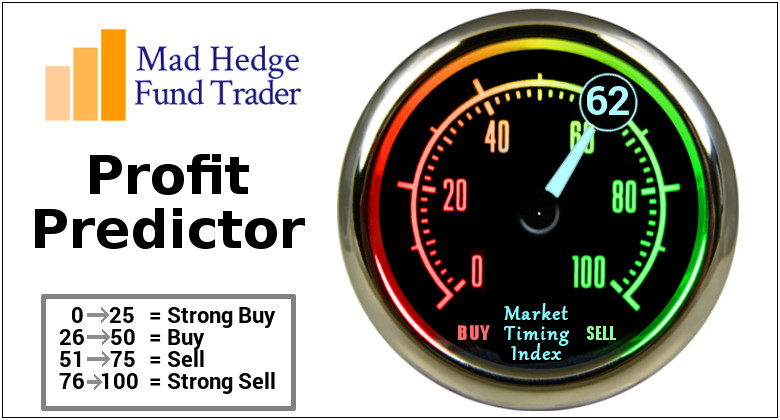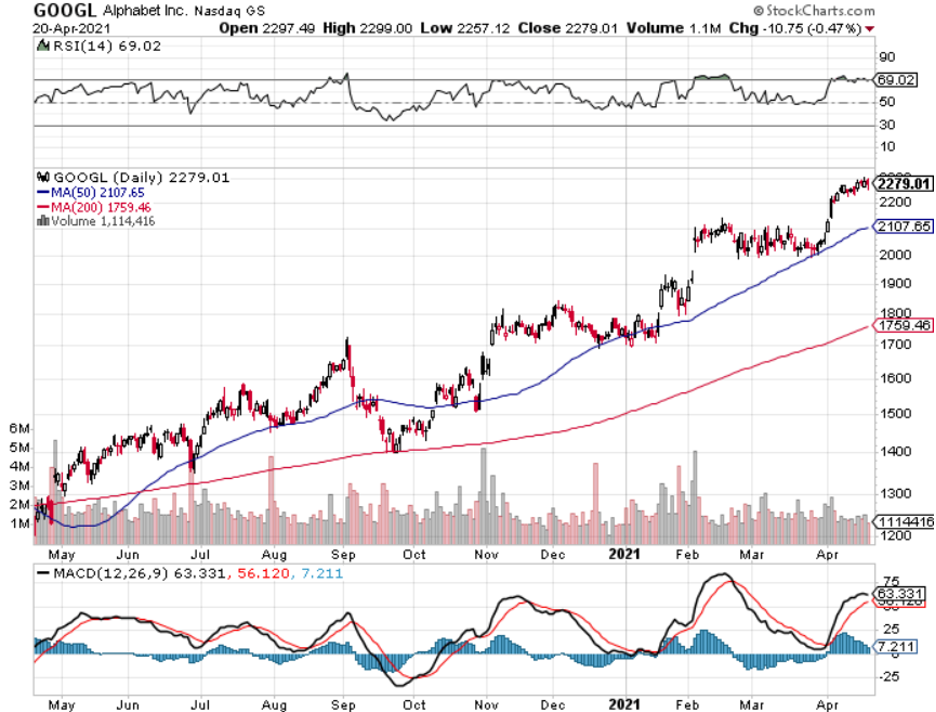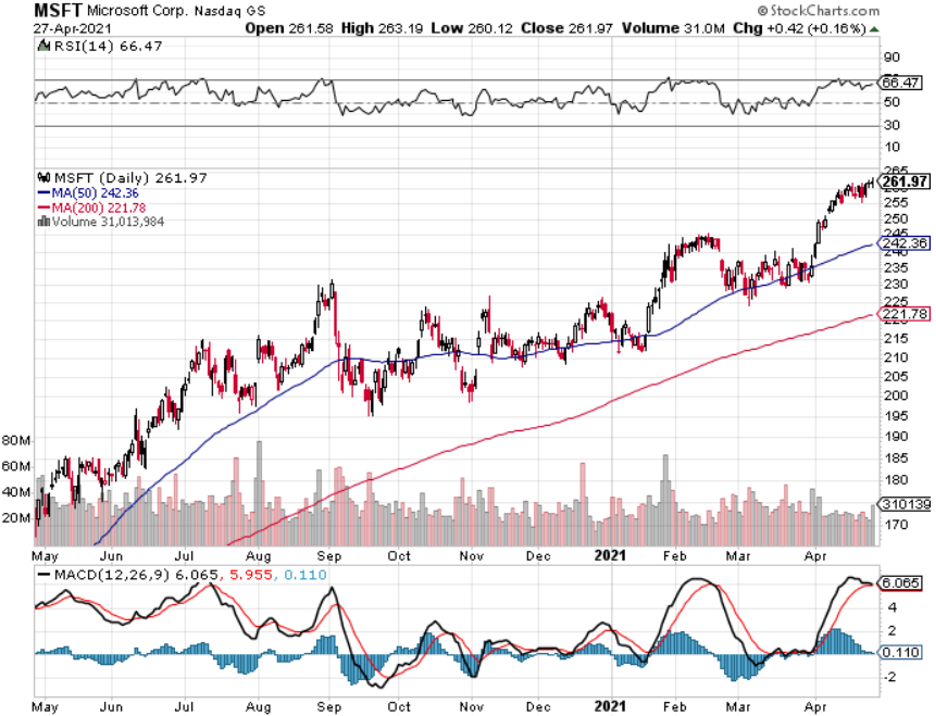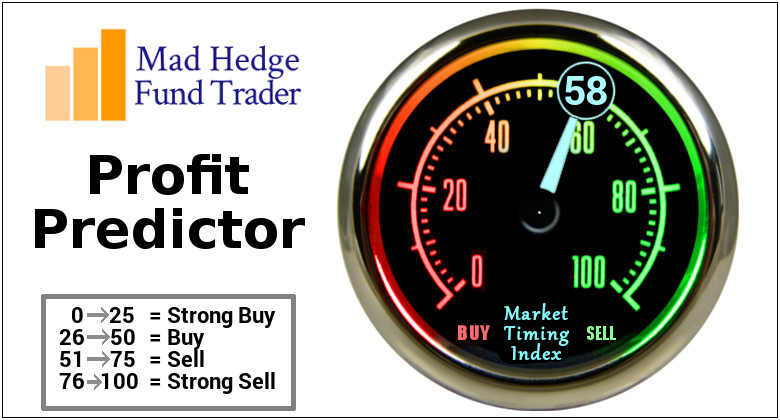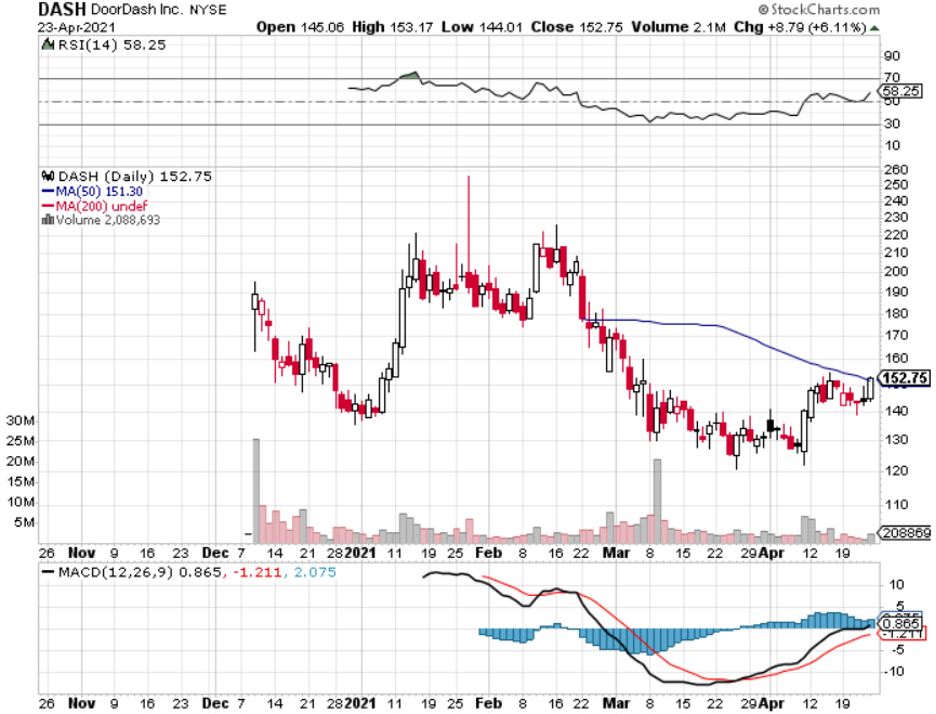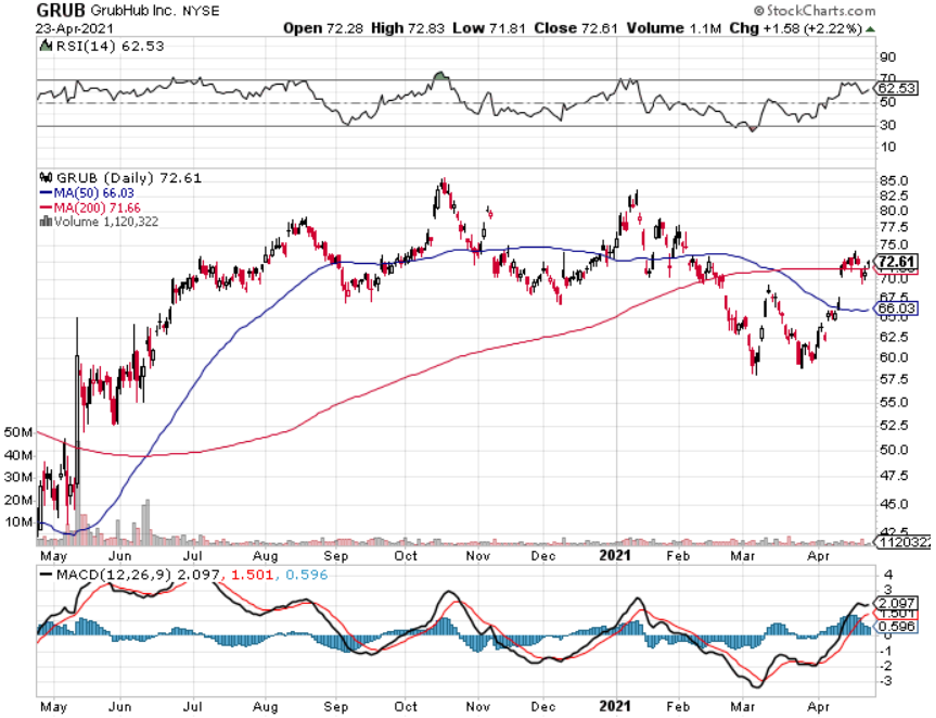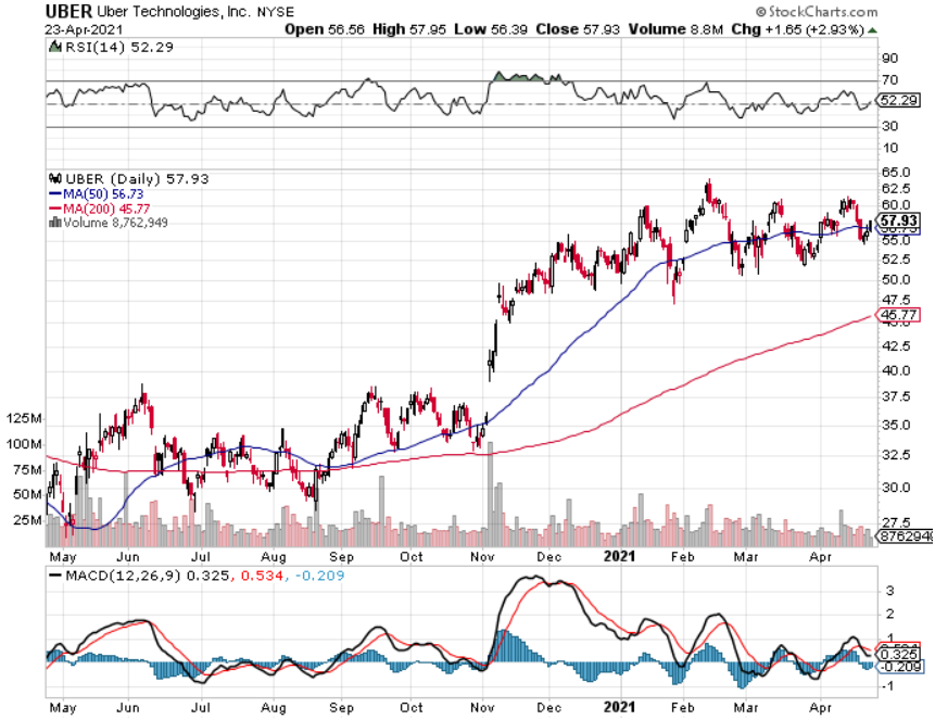“Technological progress has merely provided us with more efficient means for going backwards.” – Said English writer and philosopher Aldous Leonard Huxley
Mad Hedge Technology Letter
April 30, 2021
Fiat Lux
Featured Trade:
(A QUARTER TO REMEMBER FOR TIM COOK)
(AMZN), (AAPL)
Investors looking to park their cash in an emerging tech stock have to reckon with the earnings’ strength of a company like Apple (AAPL).
Eventually, any artisanal tech company hoping to deliver you a 10 bagger will need to adjust their sights that at some point in their future, they will need to directly compete with an Apple or Amazon (AMZN).
That is what is so scary for the little guys.
There were bountiful eye-popping numbers serving as ironclad proof to investors that sticking with the Goliaths is the sure-fire approach to grind your way up to more wealth.
A tech company Apple’s size expanding quarterly revenue to almost $90 billion last quarter representing a 54% year-over-year growth rate is stuff of legends.
A 54% growth rate is what us analysts give a green light for regardless of the size of the company.
Many analysts like to resort to explaining the upcoming stifling of growth in big tech as the law of large numbers.
Apple has shown they can overcome almost anything.
And this was supposed to be the company in which they have a China issue.
The consensus is that Apple is a brilliant business with an even better operational model.
Three reasons why Apple is firing on all cylinders.
First, Apple’s installed base growth has accelerated and reached an all-time high across each major product category.
Second, the number of both transacting and paid accounts on Apple’s digital content stores reached a new all-time high during the March quarter, with paid accounts increasing double digits in each of our geographic segments.
Lastly, Apple’s paid subscriptions continued to show strong growth.
This trifecta of outperformance was why revenue in the March quarter broke a record of $89.6 billion an increase of over $31 billion or 54% from a year ago.
Management saw strong double digits in each product category, with all-time records for Mac and for services and March quarter records for iPhone and for wearables, home, and accessories.
Products revenue was a March quarter record of $72.7 billion, up 62% over a year ago.
Company gross margin was 42.5%, up 2.7% from last quarter driven by cost savings, a strong product mix and favorable foreign exchange.
iPhone revenues had a March quarter record of $47.9 billion, growing 66% year over year as the iPhone 12 family continued to be in high demand.
With unmatched 5G capability, the best camera system ever in an iPhone, and advanced durability from Ceramic Shield, this family of devices is popular with both upgraders and new customers alike.
In the US, the latest survey of consumers from 451 Research indicates customer satisfaction of over 99% for the iPhone 12 family.
Turning to services. Another all-time revenue record of $16.9 billion with all-time records for the App Store, cloud services, music, video, advertising, and payment services.
Apple’s new service offerings, Apple TV+, Apple Arcade, Apple News+, Apple Card, Apple Fitness+, as well as the Apple One bundle, continue to scale across users, content, and features and are contributing to overall services growth.
It was a quarter of sustained strength for wearables, homes, and accessories, which grew by 25% year over year.
Apple Watch is a global success story, and the category set March quarter records in each geographic segment, thanks to strong performance from both Apple Watch Series 6 and Apple Watch SE.
The Mac broke an all-time revenue record of $9.1 billion, up 70% over last year, and grew very strongly in each geographic segment.
This impressive performance was driven by the customer approval to new Macs powered by the M1 chip.
iPad performance was also outstanding with revenue of $7.8 billion, up 79%.
Where does Apple go from here?
First, hiring warm bodies and lots of them to try to meet all the extra incremental demand the company needs to satisfy in the near future.
Over the next five years, Apple will invest $430 billion, creating 20,000 jobs in the process.
The investments will support American innovation and drive economic benefits in every state, including a new North Carolina campus and job-creating investments in innovative fields like silicon engineering and 5G technology.
After hiring, Apple is laser-focused on shareholder return.
They were able to return nearly $23 billion to shareholders during the March quarter. This included 3.4 billion in dividends and equivalents and $19 billion through open market repurchases of 147 million Apple shares.
Apple’s board has authorized an additional $90 billion for share repurchases. They are also raising their dividend by 7% to $0.22 per share, and continue to plan for annual increases in the dividend going forward.
Lastly, management threw a damp towel on the feeling of success by removing guidance and talking about headwinds.
Management said that coming up, they would not offer specific financial guidance because of “continued uncertainty around the world in the near term.”
They also said that the sequential revenue decline from the March quarter to the June quarter will be greater than in prior years.
Second, supply constraints will have a revenue impact of 3 to $4 billion in the June quarter meaning a lack of chips.
All in all, hard to be happier if you are an Apple long-term holder. This is a no-brainer buy and hold forever. Any substantial dip should be bought.
“Being the richest man in the cemetery doesn't matter to me. Going to bed at night saying we've done something wonderful, that's what matters to me.” – Said Co-Founder of Apple Steve Jobs
Mad Hedge Technology Letter
April 28, 2021
Fiat Lux
Featured Trade:
(ALPHABET IS A $3,000 STOCK)
(GOOGL), (MSFT), (AMZN), (AAPL), (TSLA)
A company that did $182 billion of annual revenue last year expanding first quarter revenue at a 34% clip year-over-year is something that is hard to contemplate; but that is how big the big have gotten, and at the top of the heap is Alphabet (GOOGL).
Expect similar type of earnings reports from Amazon (AMZN).
The 4 tech firms of Alphabet (GOOGL), Apple (AAPL), Microsoft (MSFT) and Tesla (TSLA) were in perfect strategic position going into the public health crisis, and now we find ourselves almost at the climax of it, they are validating their current position in 2021 as companies that flourished through the pandemic and now find themselves with only green pastures in front of them.
Google has said it operates in a “competitive market place” but I do not know anyone who uses an internet search service that isn’t named Google.
It’s like trying to live in China without using Wechat, Alibaba, and Baidu.
We are talking about services that perform like utilities.
Just analyze consumers’ behavior during the onslaught of the public health crisis.
Their first reaction was to delegate these important moments to Google Search.
Billions of searches every day for “COVID” and related health information took place.
At the same time, people started to job search on Google as million lost their jobs and these unemployed first reaction was to do a google search on unemployment benefits and where they could find a job.
To help them, job seekers can now use Search quickly and easily find roles that do not require a college degree and Google is working together with the top employment websites to make the service even better.
And if you thought the reach of Google stopped there, then what about when not searching for jobs or health solutions on Google search.
Well, first, food delivery searches on Google, then, conveniently, since lockdowns pervaded the world, YouTube’s video streaming had its best year.
Users continue to find all types of informational content, from educational videos to podcasts on YouTube.
In fact, according to a recent study conducted by Ipsos, 77% of respondents say they used YouTube during 2020 to learn a new skill.
YouTube Shorts, Google’s TikTok imitation service, continues to gain popularity with over 6.5 billion daily views as of March, up from 3.5 billion at the end of 2020.
The financial metrics backed up the popularity in YouTube with YouTube advertising revenues of $6 billion, up 49%, driven by exceptional performance in direct response and ongoing strength in brand advertising.
Network advertising revenues of $6.8 billion, up 30%, driven by AdMob and Ad Manager.
What if you don’t have a device to watch YouTube or search on Google Search for jobs and food delivery?
Easy answer, buy a Google device.
Other revenues were $6.5 billion, up 46%, primarily driven by growth in Play and YouTube non-advertising revenues, followed by hardware, which benefited from the addition of Fitbit revenues. Google Services operating income was $19.5 billion, up 69%, and the operating margin was 38%.
Google has you covered.
Then what about the people who have jobs and need a cloud to store their files.
Google’s Cloud segment, including GCP and Google Workspace, revenues were $4 billion for the first quarter, up 46%.
GCP's revenue growth was again meaningfully above Cloud overall. Strong growth in Google Workspace revenues was driven by growth in both seats and average revenue per seat.
Google has that covered as well and fusing their cloud operability with Google’s suite of services like Gmail has been reliable for many work from home workers.
This company has covered all their bases and they were doing this before the public health crisis.
Alphabet currently has $1.55 trillion of market cap, but this is easily a $2 trillion company on its way to $3 trillion with no headwinds in sight.
I wouldn’t even call regulation that big of risk and obviously investors keep piling into this stock because they know that even if Google gets broken up, each individual part will be worth more unpacked as a single service because they are the best of breed already.
Microsoft and Alphabet are the two companies vying for the best and most powerful in the world.
At, $1.97 trillion in market cap, Microsoft is more expensive than Google because even though they both earn over $40 billion in profits per year, Microsoft makes that on 27% less revenue than Alphabet which is why they have a higher premium.
Microsoft is more efficient than Alphabet, but again, if Alphabet is broken up, watch for efficiency metrics to skyrocket as each individual business isn’t hindered by the bureaucracy that has turned into how Google operates.
If Alphabet can inch up the margin story, they will be a $2 trillion company and $3,000 stock by the end of 2021.
“I don’t want to be liked.” – Said Founder and Former CEO of Alibaba Jack Ma
Mad Hedge Technology Letter
April 26, 2021
Fiat Lux
Featured Trade:
(BUY OR SELL DOORDASH?)
(DASH), (GRUB), (UBER)
As the work from home economy de-levers, the biggest loser of this trend will be the food delivery company DoorDash (DASH).
As the stock rallied last Friday by 6% into the close, I couldn’t help but think to myself that it is a great time to short the stock.
Considering that total sales grew close to 400% last year but the stock is lower, this basically means that DASH couldn’t deliver what shareholders wanted in a historic year for most tech companies.
What makes anyone think that 2021 will be different?
Imagine what the next phase of development looks like, quite bleak.
The health crisis unlocked a tsunami of growth for many emerging and unprofitable technologies.
Software and hardware companies were clear beneficiaries of economic lockdowns that triggered a boom in the food delivery industry.
With nowhere to eat out at, the business of eating a prepared meal was effectively handed to DoorDash on a silver spoon.
Despite this powerful tailwind, the company still failed to deliver positive earnings amid additional expenditure such as marketing.
As the pandemic navigates towards a solid solution and consumers return to restaurants, DoorDash will be left holding the bag.
First, let me say, DoorDash’s operating narrative is weak.
They earn revenue by taking a percentage of restaurant sales on its platform.
A glorified pizza delivery boy at scale is what they really are.
They describe sales as marketplace gross order value or GOV which totaled $24.66 billion in 2020 — a 326% increase over 2019.
In short, it's the total amount of money that DoorDash users paid for food.
For context, this metric grew 187% in 2019 compared to 2018, but off a much lower base from $2.8 billion and now project marketplace GOV in 2021 in the range of $30 billion to $33 billion, which is a substantial deceleration in growth rate from 2020.
The bottom line is they are still losing around the same amount of money with no solution in sight.
The next steps of the global economies are to open further, with fewer people staying home and using food delivery, so the question is whether the DoorDash marketplace will grow at all this year.
Despite a record 2020 that more than quadrupled the company's revenues, it is becoming clear that DoorDash will not even be close to profitable.
It appears DoorDash's growth in costs tracked closely with growth in revenue, in dollar terms, leading to net losses that only marginally improved.
The main thesis of these gig economies is that they become incrementally profitable at scale, but DoorDash’s financials suggest it isn’t.
I would like to hear what the next way forward is, but the firm is essentially a one-trick pony in a hopeless industry.
If interests tick higher and regulation toughens, this stock will get hit hard.
There are too many tech firms in the food delivery space and consolidation will force management’s hand.
Uber Eats is the reason that DASH won’t be able to raise prices.
DoorDash holds an advantage with 55% of the US market, but both Uber Eats (at 21%) and GrubHub (GRUB) (at 16%) have made aggressive acquisitions to help them grab market share.
All of these companies often mirror age products with no differentiation.
It is a very homogenized product.
Uber Eats has the largest global footprint in the industry, with a higher overall gross order value that hit record levels in 2020, yet that company loses money like DASH.
GrubHub also delivers the same terrible unit economics that DASH does, giving investors higher revenue but marginal margin improvements and profitability.
Companies that cannot become profitable when 4X their revenue need to be overlooked and this statement could cut across all industries from energy to retail.
Imagine that Dash also couldn’t improve unit economics when gas prices cratered as well.
It appears that Dash will have most external forces working against them for the rest of the year and this is a great stock to sell rallies on.
The initial peak of $230 could well become the peak for this stock and the current share price is 1/3 lower, but I believe a fair market cap would be half the peak of $230 in 2021.
“If the Starbucks secret is a smile when you get your latte... ours is that the Web site adapts to the individual's taste.” – Said Founder and CEO of Netflix Reed Hastings
Legal Disclaimer
There is a very high degree of risk involved in trading. Past results are not indicative of future returns. MadHedgeFundTrader.com and all individuals affiliated with this site assume no responsibilities for your trading and investment results. The indicators, strategies, columns, articles and all other features are for educational purposes only and should not be construed as investment advice. Information for futures trading observations are obtained from sources believed to be reliable, but we do not warrant its completeness or accuracy, or warrant any results from the use of the information. Your use of the trading observations is entirely at your own risk and it is your sole responsibility to evaluate the accuracy, completeness and usefulness of the information. You must assess the risk of any trade with your broker and make your own independent decisions regarding any securities mentioned herein. Affiliates of MadHedgeFundTrader.com may have a position or effect transactions in the securities described herein (or options thereon) and/or otherwise employ trading strategies that may be consistent or inconsistent with the provided strategies.


